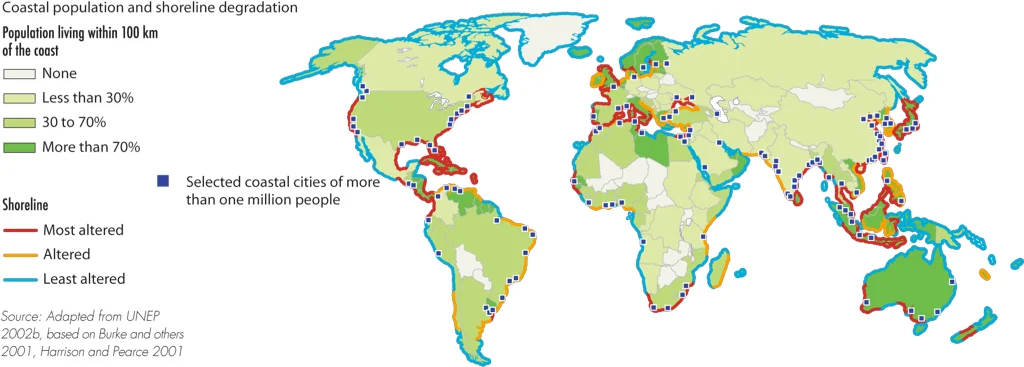Shoreline degradation refers to the deterioration or erosion of coastal areas, including beaches, dunes, and cliffs. It is primarily caused by natural processes such as wave action, storms, and tides, but human activities can significantly exacerbate the problem. Human-induced factors contributing to shoreline degradation include coastal development, sand mining, pollution, climate change, and unsustainable coastal management practices.
The map below crated by a non-profit environmental communications GRID-Arendal shows coastal population and shoreline degradation.
Population size can have a significant impact on coastal degradation. Here are a few ways in which population size can affect coastal degradation:
- Urbanization and Infrastructure: As the population increases, there is a greater demand for coastal areas for housing, tourism, and industry. This leads to the construction of coastal infrastructure such as buildings, roads, ports, and harbors. The alteration of natural coastal features, including wetlands and mangroves, and the construction of hard structures like seawalls and jetties can disrupt natural sediment flows, exacerbating erosion and altering the natural balance of coastal ecosystems.
- Increased Pollution: Higher population densities along the coast can result in increased pollution from sewage, industrial discharges, and runoff from urban areas. These pollutants can degrade water quality, harm marine life, and contribute to the degradation of coastal ecosystems.
- Overfishing and Habitat Destruction: Growing populations can put pressure on coastal fisheries, leading to overfishing and the destruction of critical habitats such as coral reefs, seagrass beds, and mangrove forests. These habitats provide important protection against coastal erosion by absorbing wave energy and stabilizing sediments.
- Climate Change: While population size itself may not directly cause climate change, the increased emission of greenhouse gases associated with larger populations contributes to global warming. Rising sea levels, increased storm intensity, and altered weather patterns associated with climate change can accelerate coastal erosion and destabilize shorelines.
- Resource Extraction: Growing populations demand more resources, including sand for construction and coastal nourishment. Unsustainable sand mining practices can deplete beach and dune systems, leading to accelerated erosion and increased vulnerability to storms.

This post may contain affiliate links. As an Amazon Associate, I earn from qualifying purchases.
Comments
Post a Comment